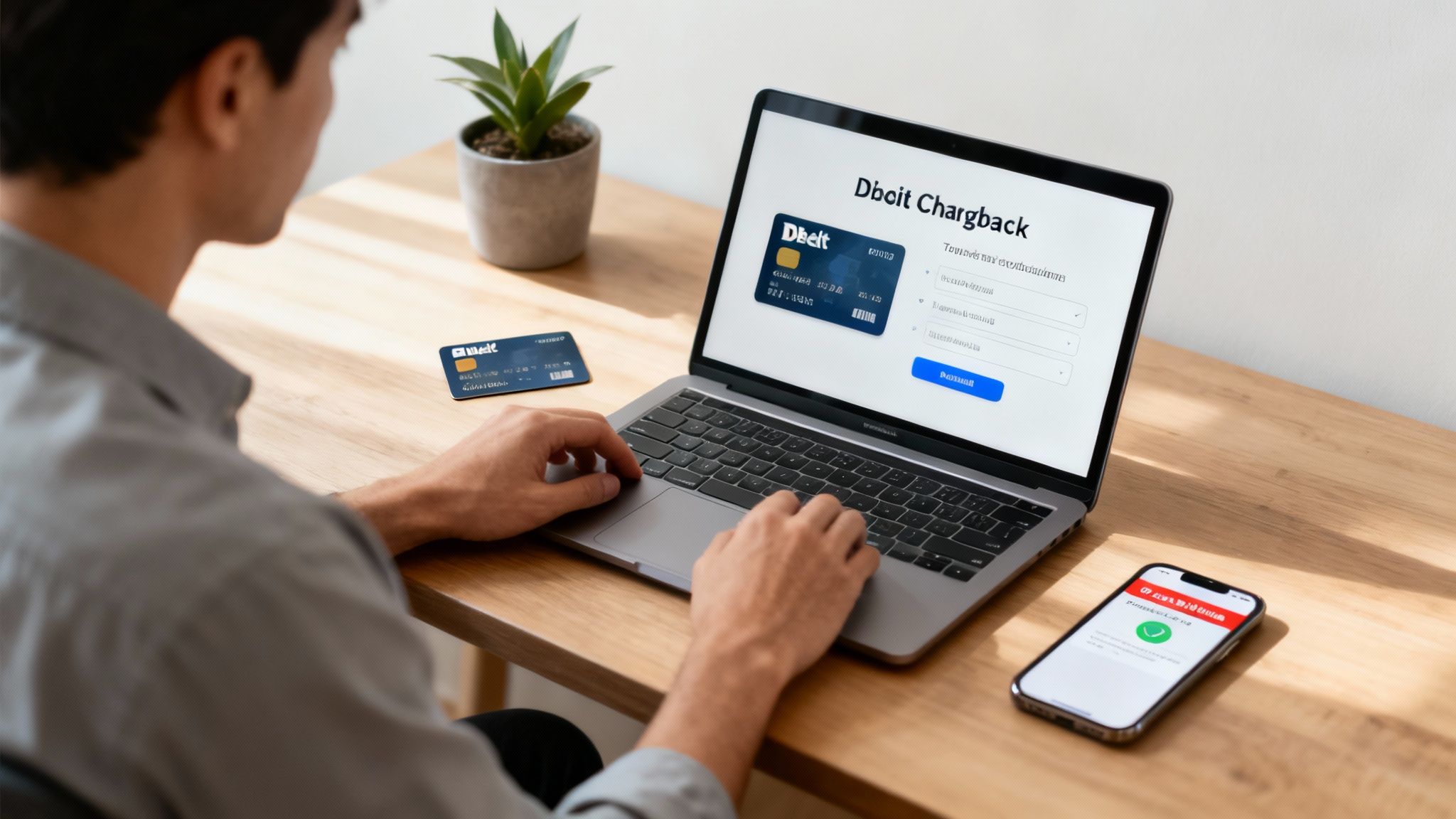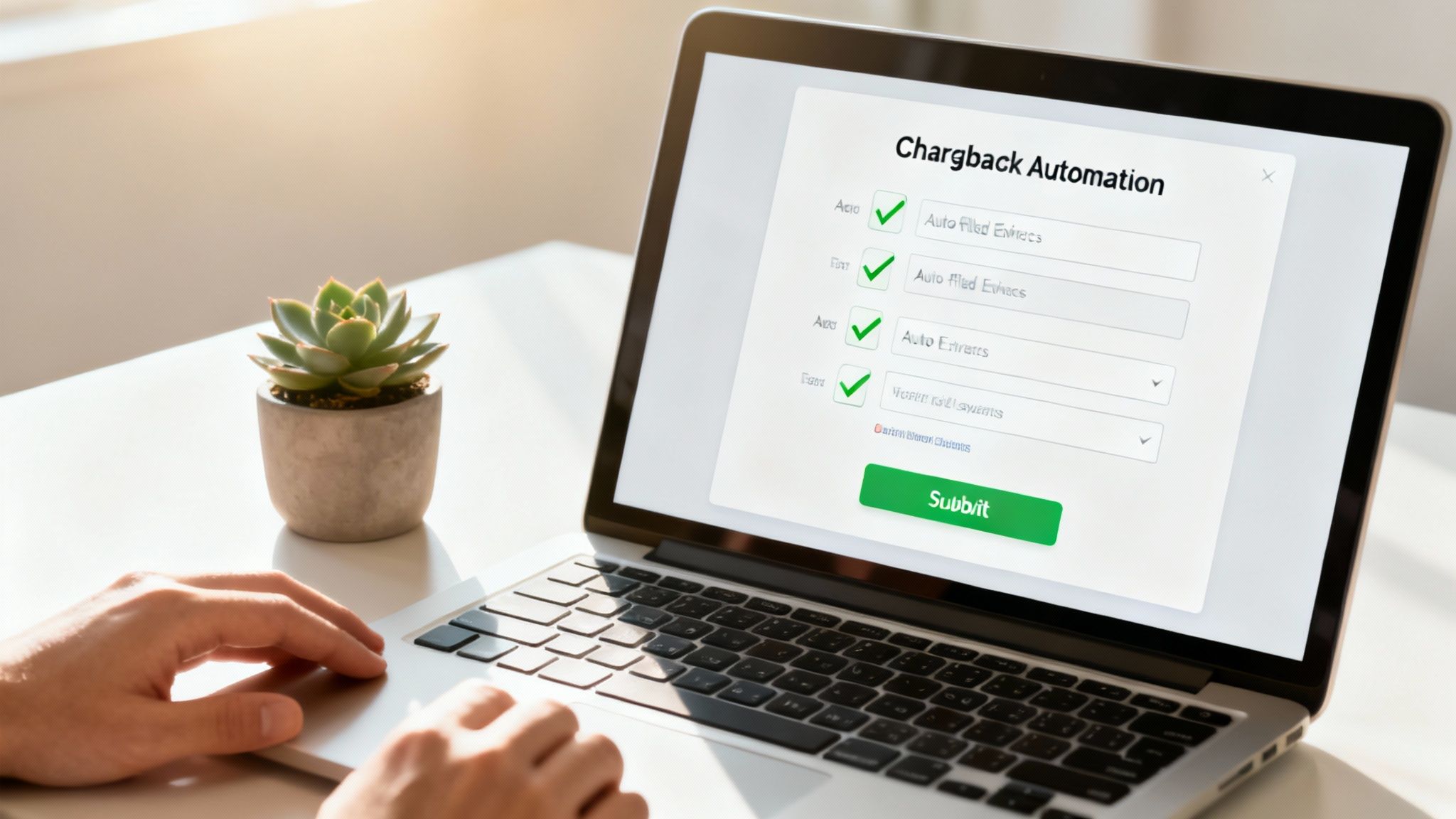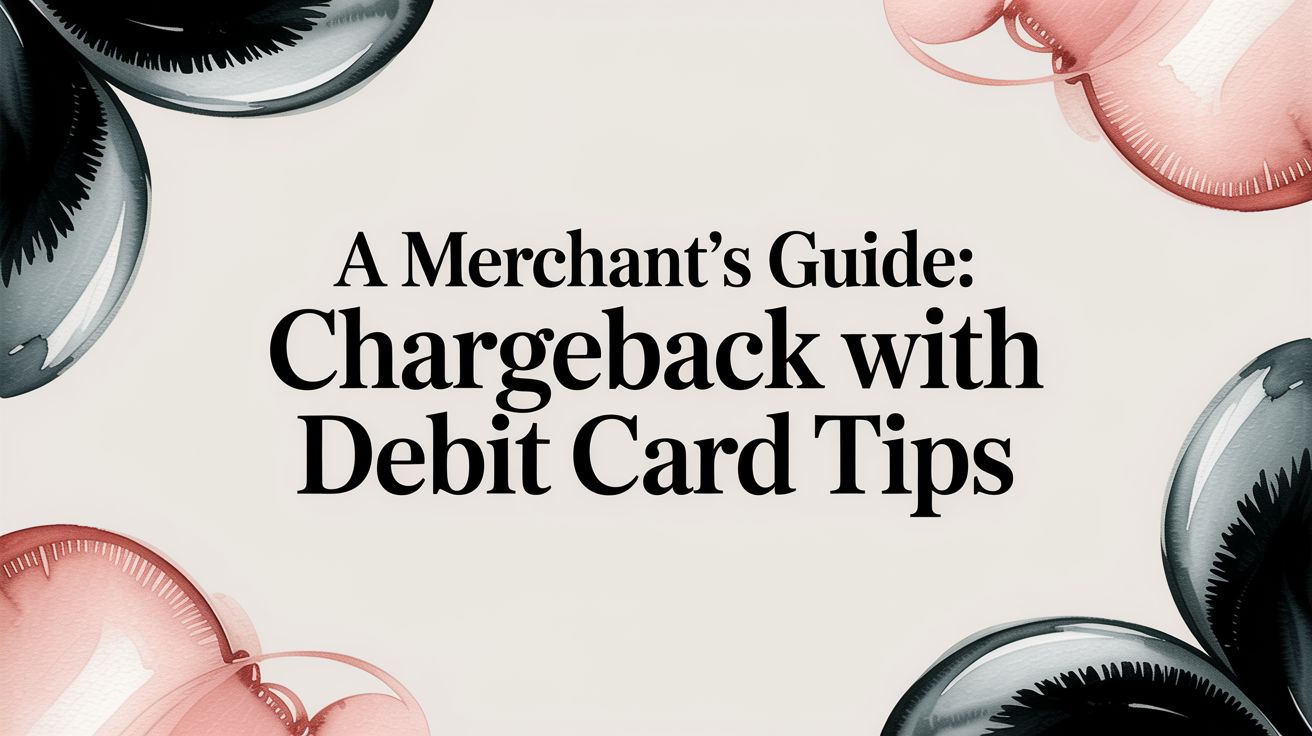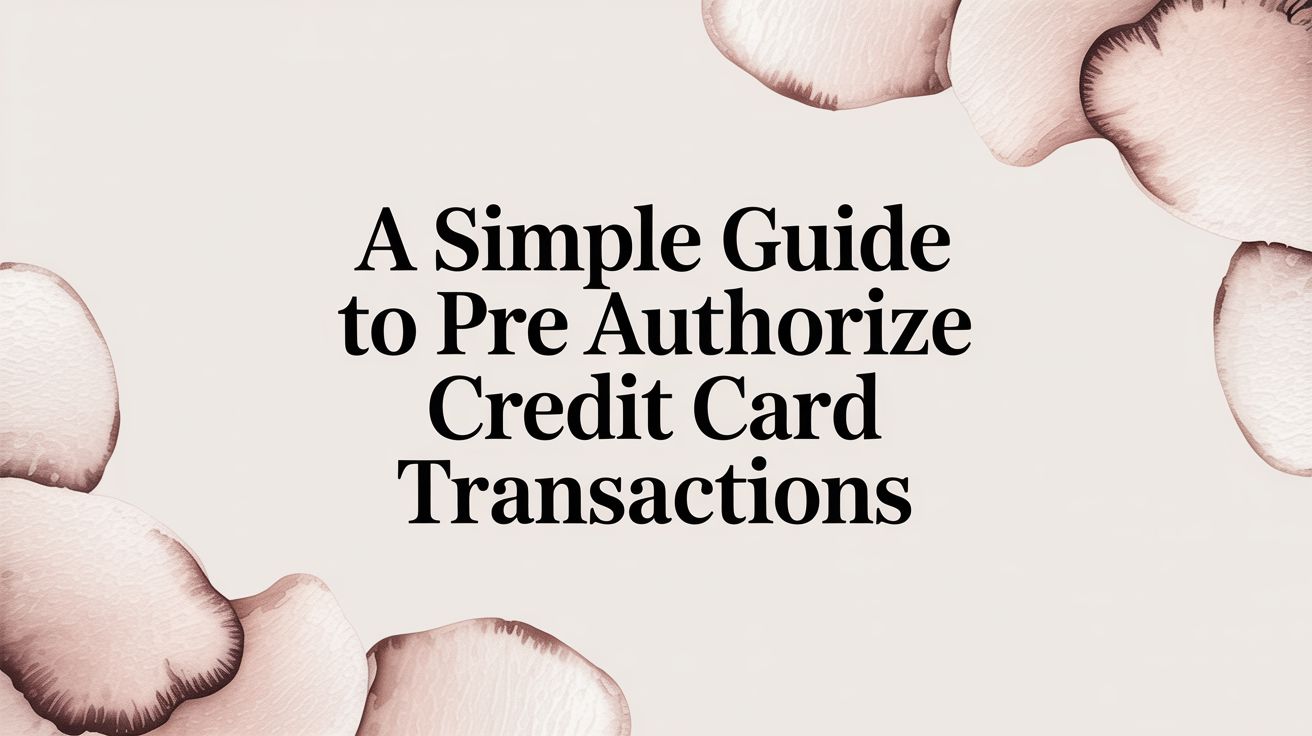
Getting a chargeback notification is a gut punch for any business owner. But when it’s a chargeback with a debit card, it just feels different—more confusing and often more urgent. While the end result is the same (money yanked from your account), the rules of the game are stricter.
Why? Because the funds are pulled directly from your customer's bank account, not a line of credit. Grasping this core difference is the first step toward actually protecting your revenue.
How Debit Card Chargebacks Really Affect Your Business

When a customer disputes a credit card purchase, the process is governed by the Fair Credit Billing Act (FCBA). This law gives consumers broad protections for credit-based transactions. But debit card chargebacks operate under a completely different playbook: the Electronic Fund Transfer Act (EFTA).
For you, the merchant, this isn't just legal jargon—it's critical. The EFTA was built to shield consumers from unauthorized electronic transfers, which means the process is more rigid, and the timelines to fight back are often painfully short.
The Real-World Impact on Your Business
The most obvious hit from a chargeback is the lost sale. But the bleeding doesn't stop there. For every single dispute, your payment processor slaps you with a non-refundable chargeback fee, usually somewhere between $20 to $100. You pay this whether you win or lose.
A single chargeback doesn't just reverse a sale; it costs you the original revenue, the value of the product or service provided, and additional penalty fees. This financial sting is why a proactive approach is so important.
On top of that, a high chargeback ratio puts your entire merchant account in jeopardy. Payment processors are watching your dispute rate like a hawk. If it creeps over their threshold, you could be looking at higher processing fees or even account termination. If you want to dive deeper, our article on how chargebacks hurt businesses breaks down the long-term consequences.
Debit Card vs Credit Card Chargeback Differences
To put it plainly, these are not the same beast. Here’s a quick rundown of the crucial distinctions every merchant needs to know.
Understanding these differences is key. With debit card disputes, the bank is often under more pressure to act fast because real cash is on the line, which translates into less breathing room for you to build your case.
Why the Stakes Are Higher Now
Chargebacks aren't just a nuisance; they're a growing threat. The explosion of e-commerce has, unfortunately, brought a surge in disputes right along with it.
- Global chargeback volumes are projected to hit a staggering 337 million cases by the end of 2025.
- That’s a 27% jump from the 265 million cases we saw back in 2022.
- This spike is overwhelmingly fueled by card-not-present (CNP) transactions—the bread and butter of online retail.
Because a debit card chargeback involves a direct withdrawal from someone’s bank account, both the bank and the customer treat the situation with a heightened sense of urgency. For you, this means there's zero time to waste. A swift, organized, and evidence-packed response isn't just a good idea—it's essential for survival.
Building Your Winning Representment Case
Once a customer files a chargeback with their debit card, the dispute process kicks off immediately, and you’re officially on the clock. Winning this fight comes down to one thing: providing strong, compelling evidence that proves the transaction was legitimate. This goes way beyond just showing a delivery confirmation; you need to build an ironclad case that leaves no room for doubt.
Think of yourself as a detective. Your goal is to piece together a complete story of the transaction, from the moment the customer landed on your site to the point they received their product or service. Every bit of data helps paint a clearer picture for the bank reviewing the case.
Your Essential Evidence Checklist
To effectively fight a debit card chargeback, you need to gather specific types of proof. Banks want to see concrete data that validates the purchase, not just your word against the customer's.
Here’s a practical checklist of what you should start collecting right away:
- Customer Communications: Save everything. This includes emails, support tickets, chat logs, or even social media messages where the customer discusses the purchase or their account.
- Transaction Authentication Data: This is your technical proof. Be sure to pull the AVS (Address Verification System) and CVV match results. A full match is a powerful indicator that the legitimate cardholder made the purchase.
- IP Address Logs: Note the IP address used for the purchase and cross-reference it with the customer’s billing address location. If they match, it significantly strengthens your claim that the real cardholder was involved.
- Digital Receipts and Invoices: Always include a copy of the receipt you sent to the customer. It should show a clear breakdown of what was purchased, the total cost, and the billing information they provided.
Remember, the bank employee reviewing your case wasn't there when the transaction happened. Your job is to present the evidence so clearly and logically that they can only reach one conclusion—that the charge was valid.
A Real-World Scenario: The Digital Subscription Dispute
Let's imagine a customer disputes a $99 charge for an annual subscription to your software, claiming they never authorized it. This is a classic "friendly fraud" scenario. You know they signed up and used the service, but now they're trying to get their money back.
To win this debit card chargeback, you can't just send the invoice. You need to build a comprehensive evidence package.
Here's how you'd do it:
- Proof of Authorization: Start with the basics—the AVS and CVV codes matched during the transaction. Then, show that the IP address from the signup location corresponds to the customer’s billing city. This immediately casts doubt on their "unauthorized" claim.
- Proof of Service Usage: This is your knockout punch. Provide server logs showing the customer’s account activity. You'll want to include the dates and times they logged in, features they used, or files they downloaded. For example, show that they logged in 15 times over the past three months.
- Proof of Communication: Include the welcome email they received upon signing up and any subsequent marketing or notification emails sent to their verified address. Did they ever contact your support team? Add those chat logs too.
By combining these elements, you’re not just saying the charge was legitimate; you're proving it with a detailed timeline of the customer’s own actions.
For a deeper dive into crafting your response, our guide on chargeback representment offers more advanced strategies. This methodical approach is exactly what banks need to see to reverse a debit card chargeback in your favor.
A Merchant's Walkthrough of the Dispute Process
Getting a debit card chargeback notification can feel like a fire alarm—it’s sudden, loud, and you need to act now. The whole process is way less forgiving than what you might be used to with credit cards, mostly because the timelines are incredibly tight. If you miss a deadline, even by a day, it's pretty much an automatic loss.
Your job starts the second that notification from your payment processor hits your inbox. This isn't something you can just file away for later. It’s your cue to drop what you're doing and start digging in. The clock is ticking, and every hour is critical for building a solid case.
First Steps After a Dispute Notification
First thing's first: pull up the transaction in your system. Don't go by memory. You need to see the order details with your own eyes—what was bought, when it was shipped or delivered, and the exact cost.
At the same time, create a dedicated case file for this dispute. Whether you use a digital folder or a physical one doesn't matter, but this is where every single piece of evidence will live. Getting organized right from the jump will save you from that last-minute, panicked scramble when the deadline is staring you down.
The infographic below really nails the core workflow for building your case.

This simple flow—Gather, Analyze, Submit—is your best defense. A methodical approach is what wins debit card chargebacks, period.
Writing a Compelling Rebuttal Letter
Once all your evidence is in one place, you need to package it neatly into a rebuttal letter. Think of this letter as your one shot to talk directly to the bank employee reviewing the case. It needs to be professional, packed with facts, and dead simple to understand. Leave emotion out of it; let the data do the talking.
Your letter should always have these key parts:
- A Clear Summary: Start with a quick summary of the transaction. Include the date, amount, and what was sold.
- Point-by-Point Evidence: Break down your proof logically. Use bullet points or a numbered list to walk them through each piece of evidence and explain what it proves. For example, flat-out state, "The AVS and CVV codes provided by the customer were a perfect match."
- A Professional Closing: Wrap it up by restating that the evidence confirms the transaction was legitimate. Then, respectfully ask for the chargeback to be reversed.
This kind of structure makes it easy for the bank to see the facts and rule in your favor. For a more detailed look, our guide on the card dispute process offers more templates and insider tips.
Here’s a pro tip: The person reading your letter is looking at dozens of these cases every single day. A short, well-organized letter that gets straight to the point is way more effective than a long, rambling story. Make their job easy, and you’ll boost your odds of winning.
The financial hit from chargebacks is huge and only getting bigger. By 2025, it's estimated that global chargebacks will cost merchants $33.79 billion. That number is projected to jump to $41.69 billion by 2028—a massive 23% increase in just three years. This trend, highlighted by insights from Chargeflow, shows exactly why fighting every dispute matters.
Proactive Strategies to Prevent Debit Card Disputes
Let's be honest: the best way to handle a debit card chargeback is to make sure it never happens in the first place. Sure, you can win a dispute, but that’s always a reactive, time-consuming scramble. A solid prevention strategy, on the other hand, saves you money, time, and the sheer headache of building a case.
So many disputes don't even start with malicious intent. It’s often just simple confusion. A customer glances at their bank statement, spots a charge they don’t recognize, and their first instinct is to call the bank. This is where your first line of defense comes into play, and it's surprisingly simple.
Start with Clear Communication
The single most powerful tool against "friendly fraud" is a crystal-clear billing descriptor. This is the little line of text that shows up next to a transaction on a customer's statement. Instead of your generic legal company name or, even worse, a jumble of random characters, make it instantly recognizable.
Try a format like:
- YOURBRANDNAME*PRODUCT
- YOURWEBSITE.COM*SUPPORT#
That small detail immediately connects the charge to their purchase in their mind, jogging their memory and stopping that panicked phone call to the bank before it ever happens.
Beyond that, make your customer support ridiculously easy to find. Your phone number, email, and a link to your refund policy should be plastered on your website and in every order confirmation email. If a customer can sort out an issue with you in five minutes, they’re far less likely to kick off a chargeback that could drag on for weeks.
Strengthen Your Technical Defenses
Great communication is your front line, but you also need some technical muscle to filter out genuinely fraudulent transactions before they turn into problems. Think of these tools as a digital bouncer for your store, checking IDs at the door so only legitimate customers get in.
Adopting a proactive mindset here is key. While they're often discussed in a different context, the principles of software project risk management offer a great framework for identifying and heading off potential problems in any part of a business.
A proactive mindset shifts your focus from fighting fires to preventing them. By making a few key adjustments to your checkout and customer service processes, you can significantly reduce the number of disputes that hit your account.
Putting these technical checks in place is non-negotiable for any merchant selling online today:
- AVS and CVV Matching: Always, always require the Address Verification Service (AVS) and Card Verification Value (CVV) for every single transaction. This is a basic check to confirm that the person making the purchase actually has the physical card.
- 3D Secure Authentication: Technologies like Visa Secure and Mastercard Identity Check are game-changers. They add an extra step where the customer has to enter a password or a one-time code sent by their bank. Crucially, this shifts the liability for many types of fraudulent chargebacks away from you and back to the issuing bank.
The e-commerce world never stands still. We saw e-commerce chargebacks jump by a staggering 222% between Q1 2023 and Q1 2024, fueled by massive online shopping volumes and delivery snafus. You can discover more insights about chargeback stats on Chargebacks911.com to see the bigger picture.
For an even deeper dive into this, check out our own guide on how to prevent chargebacks, where we cover more advanced tactics.
Using Automation for Smarter Chargeback Management
Manually fighting every single debit card chargeback is a huge time drain. I’ve seen it countless times with merchants. What starts as a minor annoyance quickly balloons into a major operational headache as your business grows. Your team ends up digging through different systems, taking screenshots, and writing rebuttal letters from scratch—all while a strict deadline looms.
This is where automation completely changes the game.
Instead of treating each dispute as a manual fire drill, you can use a system that does the heavy lifting for you. It’s not about replacing your team’s judgment, but about giving them the right tools to respond faster, more accurately, and with a much higher chance of winning.

A platform like this can transform a messy, multi-step chore into a clear, manageable workflow.
The Old Way vs. The Automated Way
Think about the manual process for a typical chargeback. First, you get a notification. Then, someone on your team has to log into Shopify, your shipping provider, and maybe even your CRM just to pull all the necessary evidence. It’s slow, clunky, and incredibly prone to human error.
Now, let's contrast that with an automated workflow:
- A new chargeback comes in, and a system like ChargePay is instantly notified.
- The software automatically taps into your payment processor and other integrated tools.
- It gathers all the compelling evidence—AVS/CVV results, IP address logs, shipping confirmations, and customer communications—in seconds.
- Finally, it uses this data to pre-fill a professional rebuttal letter and submits the entire package to the bank on your behalf.
What used to take an employee 30 minutes or more per dispute now happens almost instantly, often without anyone needing to lift a finger. You can get a much deeper look into how this works in our complete guide to automated chargeback management using AI.
By automating the evidence-gathering and submission process, you eliminate the risk of missing a deadline and ensure every single dispute is fought with the strongest possible evidence. This turns a major cost center into a predictable, manageable part of your operations.
More Than Just Chargebacks
Adopting automation for disputes is really part of a larger trend of making financial operations more efficient. If you want to see how this applies elsewhere, exploring resources on accounts payable automation can offer some great insights. The core idea is the same: letting technology handle the repetitive tasks so your team can focus on growth.
Ultimately, smart automation empowers you to fight every dispute, no matter how small the transaction value might be. This not only recovers lost revenue but also sends a clear message that you take every chargeback seriously, which helps protect your merchant account health in the long run.
Common Questions About Debit Card Chargebacks
Even after walking through the whole process, it’s normal to have a few questions rattling around about how a chargeback with a debit card actually plays out. The rules can feel a little murky, and let’s be honest, every situation seems to have its own unique twist.
Let’s clear up some of the most common points of confusion merchants run into. Think of this as your quick-reference guide for those "what if" moments that inevitably pop up.
Are Debit Card Chargebacks Harder to Win?
They can definitely feel that way, and it’s not just in your head. The biggest hurdle is time. The response windows for debit card disputes are often brutally short compared to credit cards, giving you a tiny sliver of time to pull together your evidence and build a case. If you're not on top of it, the deadline can fly by before you've even started.
Plus, since the money comes straight from a customer’s bank account, banks sometimes have a knee-jerk reaction to protect their account holder first. But that absolutely doesn’t mean it's a lost cause.
With solid, compelling evidence that proves the customer authorized the transaction and got what they paid for, you have a very strong chance of winning. It all comes down to meticulous records and a lightning-fast response.
What Is the Biggest Merchant Mistake?
By a country mile, the single biggest mistake merchants make is missing the response deadline. It sounds so basic, but it happens constantly. Debit card networks are incredibly strict with their time limits—there are no extensions, no second chances.
If you miss that window, even by an hour, you automatically lose the dispute. It doesn’t matter if you have a mountain of flawless evidence proving your case. A late submission is an automatic forfeit. The funds are gone for good. Using calendar reminders or, better yet, an automated system is critical to avoiding this simple but devastating error.
Can I Contact the Customer Directly?
Yes, and you absolutely should. In many cases, it's the smartest first move. A quick, professional, and genuinely helpful email or phone call can often resolve the entire issue without ever having to get into the formal dispute process.
You'd be surprised how often a customer simply doesn't recognize your business name on their bank statement. This is a classic case of "friendly fraud."
Here's how to handle it:
- Explain the Charge: Politely remind them of their purchase. Mention the date and the specific product or service they bought to jog their memory.
- Offer a Solution: If there was a genuine mix-up or problem, offer a refund or another solution directly. It’s almost always cheaper than eating a chargeback fee.
- Get It in Writing: If they agree it was their mistake and will withdraw the dispute, ask for a simple confirmation in an email. You can then submit that email as part of your evidence package to the bank as proof you've already resolved it.
This direct approach can save you a ton of time, money, and most importantly, protect your chargeback ratio.
Fighting debit card chargebacks manually is a drain on your time and resources. ChargePay uses AI to automate the entire dispute process, from gathering evidence to submitting winning responses, helping you recover up to 80% of lost revenue hands-free. Protect your business and reclaim your profits with ChargePay.






.svg)







.svg)
.svg)
.svg)